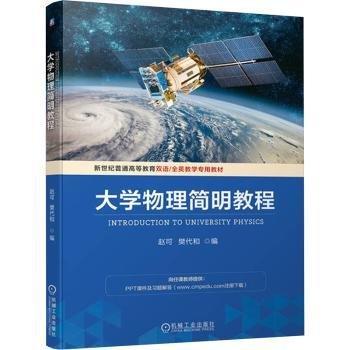前言
chapter 1 kinematics
1.1preparations
1.1.1coordinates,discement and distance
1.1.2vectors and scalars
1.2velocity and acceleration
1.2.1velocity
1.2.2acceleration
1.2.3graphical analysis
1.3motion with constant acceleration
1.3.1one-dimensional motion
1.3.2motion under gravity and projectile motion
1.4frame of reference
problems and exercises
chapter 2 newton’s laws andforces
2.1newtons laws of motion
2.2free-body diagram and forces
2.2.1free-body diagram
2.2.2normal force
2.2.3tension
2.2.4friction
2.2.5drag force
2.3elasticity
problems and exercises
chapter 3 work and energy
3.1work and kiic energy
3.2gravitational potential energy
3.3potential energy of elastic spring
3.4conservation of mechanical energy
problems and exercises
chapter 4 momentum and collisions
4.1momentum and impulse
4.1.1momentum
4.1.2impulse
4.1.3impulse and average force
4.1.4conservation of momentum
4.2collisions
4.2.1elastic collisions
4.2.2inelastic collisions
4.2.3collisions in two dimensions
problems and exercises
chapter 5 circular motion and gravity
5.1angular quantities and circular motion
5.2dynamics in circular motion
5.3newtons law of universal gravitation and motion of satellites
5.3.1newtons law of universal gravitation
5.3.2motion of satellites
problems and exercises
chapter 6 dynamics of rotation
6.1dynamics of rotational motion
6.2angular momentum and its conservation
6.2.1angular momentum
6.2.2conservation of angular momentum
6.3static equilibrium
problems and exercises
chapter 7 vibrational motions
7.1simple harmonic motion
7.1.1describing simple harmonic motion
7.1.2simple pendulum
7.1.3energy in simple harmonic oscillator
7.2damped harmonic motion and forced vibration
7.2.1damped harmonic motion
7.2.2resonance
7.3superition of simple harmonic motions
7.3.1superition of shms at the same frequency
7.3.2beats
problems and exercises
chapter 8 mechanical waves
8.1wave motion
8.1.1basic parameters of waves
8.1.2wave speed
8.1.3wave function
8.2superition of waves
8.2.1interference and stan waves
8.2.2huygens principle
8.3doppler effect
problems and exercises
chapter 9 wave optics
9.1the wave nature of light
9.1.1spectrum of electromagic waves
9.1.2the index of refraction,total internal refraction
9.2interference and diffraction
9.2.1interference between waves
9.2.2double-slit interference
9.2.3single-slit diffraction
9.2.4circular aperture and resolution ability
9.2.5diffraction grating
problems and exercises
chapter 10 introduction to quantum physics
10.1quantization of light
10.1.1black body radiation
10.1.2nck’s quantum theory
10.1.3photon model and photoelectric effect
10.2atomic models
10.2.1the bohr’s model
10.2.2spectrum of hydrogen
10.3matter wave and wave-particle duality
10.3.1de broglie’s wave
10.3.2wave-particle duality and wave function
problems and exercises
chapter 11 electric field
11.1electrostatic field
11.2electric potential
11.3conductors and insulators
11.3.1conductors in equilibrium
11.3.2dielectrics
problems and exercises
chapter 12 dc circuits
12.1resistors
12.1.1resistance of a conductor
12.1.2resistors in circuits
12.2battery
12.3kirchhoff’s rules
problems and exercises
chapter 13 capacitors
13.1capacitors in dc circuits
13.1.1capacitance
13.1.2energy stored in capacitors
13.2rc circuits
13.2.1charging through rc circuits
13.2.2discharging
problems and exercises
chapter 14 magism
14.1magic field and magic force
14.1.1mags and magic field
14.1.2magic force on moving charges
14.1.3magic force on electric current14.1.4hall effect
14.2magic field due to current-carrying wire
14.3materials in magic field and ferromagism
14.3.1paramagic materials and diamagic materials
14.3.2ferromagic materials
problems and exercises
chapter 15 electromagic induction
15.1induced emf
15.1.1faradays law of induction,lenzs law
15.1.2flux cutting
15.1.3flux linking
15.2eddy currents,electric generator,back emf and transformers
15.2.1eddy currents
15.2.2electric generator and back emf
15.2.3transformers
15.3inductance
15.3.1self-inductance and inductor
15.3.2l-r circuit and the energy in an inductor
problems and exercises
chapter 16 ac circuits
16.1ac voltage and current
16.2reactance
16.2.1capacitive reactance
16.2.2inductive reactance
16.2.3power in capacitor and inductor
16.3rlc circuits and impedance
16.3.1phasor
16.3.2impedance in ac circuits
16.3.3resonance and power in rlc circuits
16.3.4capacitor and inductor in parallel
16.4electromagics wave,production and reception
16.4.1maxwells equations 16.4.2antennas
problems and exercises
chapter 17 temperature and heat
17.1temperature and matter
17.1.1introduction to temperature
17.1.2states of matter,phase change,and phase diagram
17.1.3heat capacity
17.1.4thermal expansion
17.2heat flow
17.3ideal gas
17.3.1the ideal gas law
17.3.2molecular interpretation oftemperature
17.3.3internal energy
problems and exercises
chapter 18 laws of
thermodynamics
18.1the first law of thermodynamics
18.2thermodynamics processes for ideal gases
18.2.1isochoric,isobaric and isothermal processes
18.2.2adiabatic process
18.3cyclic processes and applications
18.3.1cyclic processes
18.3.2heat engine,heat pump and cold pump
18.4the second law of thermodynamics
18.4.1direction of thermodynamic processes
18.4.2carnot cycle and the mamum efficiency of heat engines
18.4.3entropy problems and exercisesreferences


 直播中,去观看
直播中,去观看